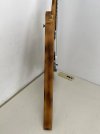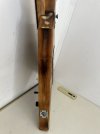Looking at a cool auction, but I can see that there are real neck pocket cracks, not just in the paint (as it's been removed). At the moment, the guitar is very inexpensive.
You think you could just glue and clamp and it'll be fine? Or so long as the neck isn't moving, just leave it be? Maybe mark it somehow and only worry if the crack starts growing?
You think you could just glue and clamp and it'll be fine? Or so long as the neck isn't moving, just leave it be? Maybe mark it somehow and only worry if the crack starts growing?



